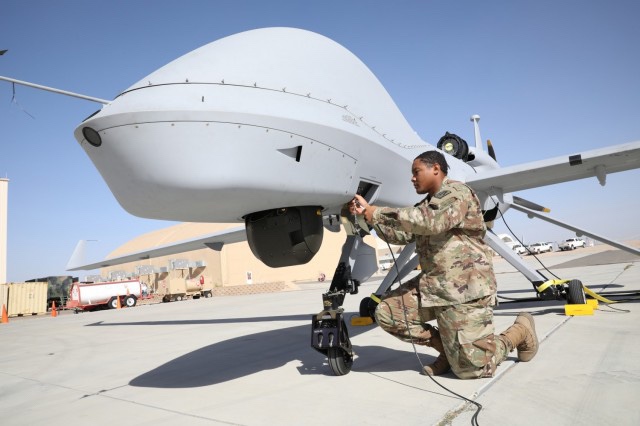
YUMA PROVING GROUND, Ariz. — Project Convergence, the Army’s campaign of learning, has returned to U.S. Army Yuma Proving Ground (YPG) to test a vast and astonishing array of new technology.
For the first time ever, every branch of the United States’ armed forces are testing their sensor-to-sensor capabilities in tandem.
In addition to representation from all branches of the military, this year’s iteration features all eight of the Army Futures Command’s cross-functional teams (CFTs). There is also a dramatically larger Soldier presence.
Among these CFTs is Future Vertical Lift (FVL), which is aggressively testing virtually every facet of the Army’s Future Attack Reconnaissance Aircraft (FARA) and FVL, as well as advancing knowledge on electronic warfare. Unmanned aircraft, air-to-ground missiles, rotary cannons, and all manner of ancillary technologies to expand communications capabilities and Soldier survivability are all being tested simultaneously here.
“There is a lot of learning going on out here over these several weeks,” said Jim Thomson, Acting Deputy Director of the Future Vertical Lift CFT. “Yuma Proving Ground is really a unique place to enable us to do this.”
YPG’s vast size includes nearly 2,000 square miles of restricted airspace. The proving ground’s clear, stable air and extremely dry climate combined with an ability to control a large swath of the radio frequency spectrum makes it a desired location for this type of testing.
YPG’s vast institutional UAS and counter-UAS testing knowledge is an added bonus, as is the presence of a wealth of other infrastructure meant for other sectors of YPG’s broad test mission that can be leveraged to support aviation evaluations. YPG is home to things like technical and tactical targets, as well as generator and combined maintenance shops.
“YPG in particular has been an outstanding host,” said Lt. Col. Tanner Spry, FVL CFT experimentation planner. “It’s a great area based on the distances that exist here to challenge our platforms.”
The breadth of equipment tested here over the course of the six-week demonstration is astonishing, and boasts multiple firsts. Testers say this year’s demonstration increased their ability to integrate into the joint force and improved the command and control network to extend the range Army aviators can operate in. This was shown multiple time in realistic scenarios in which Soldiers from the Army’s 82nd Airborne conducted simulated air assaults across YPG’s vast ranges.
“We’ll take a use case and run through multiple iterations to stress and challenge the technologies to make sure they are resilient,” said Spry.
One of the more exciting technologies used was Air Launched Effects (ALEs), drones attached to a helicopter or other vehicle that can be an aviator’s eyes in an area of interest. These remarkable and low-cost surveillance UAS can also be launched off of light ground vehicles, but integrating them into aviation platforms is much more complex.
“They’ve done a tremendous amount of work to get the ‘air launched’ into the name air launched effect,” said Thomson. “But there are a lot of other options, too.”
As for the FARA and FVL themselves, multiple other facets are being tested here. A new Gatling-style 20mm machine gun that could serve as one of the platforms’ rotary cannon was integrated into a UH-60 Black Hawk serving as a surrogate and fired in flight for the first time here.
“It shoots fast, it shoots well, and it shoots accurately,” said Lt. Col. Cameron Keogh, Chief of Flight Test for U.S. Army Combat Capabilities Development Command. “As a previous attack and recon pilot, I like it.”
With things like the Gatling-style gun, artificial intelligence-aided threat targeting and detection systems, and even the ability to fly autonomously, developers are using a modular systems approach that would enable these things to be used on a variety of aircraft as needed. During PC 21, the testers demonstrated flying a legacy UH-60 completely autonomously.
“We have to be able to demonstrate autonomy in any environment,” said Stuart Young, Defense Advanced Research Projects Agency program manager. “Yuma is a great location to be able to bring all of these different pieces together. We have a lot of flexibility that we don’t have in other locations: we have large safety margins and here we have the space we need to conduct all of these firsts safely.”
All of these technologies are being refined to prepare for the potential of warfare with a near-peer adversary. As such, the participation of hundreds of Soldiers in PC 21 was useful for testers: Engineers had the opportunity to gain input about systems under test from Soldiers who have operated earlier iterations of the platforms in theater overseas.
“We are leveraging technology to reduce Soldier workload,” said Spry. “Sometimes moving yourself out of chaos by being able to operate at greater distances and ranges can give us a strategic advantage.”
By Mark Schauer

